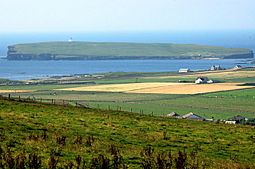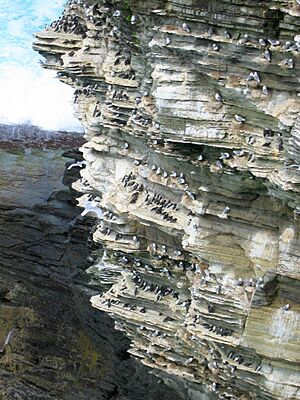Brough of Birsay facts for kids
| Norse name | Byrgisey |
|---|---|
| Meaning of name | fort island |
 |
|
| OS grid reference | HY236285 |
| Coordinates | 59°08′N 3°20′W / 59.14°N 3.33°W |
| Physical geography | |
| Island group | Orkney |
| Area | 16 ha |
| Highest elevation | 46 metres (151 feet) |
| Administration | |
| Sovereign state | United Kingdom |
| Country | Scotland |
| Council area | Orkney Islands |
| Demographics | |
| Population | 0 |
The Brough of Birsay is a small, empty island near the northwest coast of Mainland Orkney, Scotland. It's in a place called Birsay. This island is about 13 miles north of Stromness. You can find old ruins from the Pictish people and the Norse here. There's also a modern lighthouse on the island.
Contents
Island Basics: What is the Brough of Birsay?
Getting to the Island
The Brough of Birsay is a tidal island. This means you can only reach it at certain times. When the tide is low, a natural path called a causeway appears. You can walk across this path to get to the island. At high tide, the island is separated from the mainland by about 240 meters of water. This water is known as the Sound of Birsay.
Why the Island is Called Brough
The name "Brough" comes from an old Norse word, "Byrgisey." This word means "fort island." So, the island's name tells us it was once a place with a fort. The nearby area, Birsay, also gets its name from this old word.
Exploring the Past: Who Lived on the Brough of Birsay?
The Brough of Birsay has a long and interesting history. People have lived here for many centuries.
The Earliest People: Picts
The first people to settle on the island were likely Christian missionaries around the 6th century. By the 7th and 8th centuries, the island became an important fortress for the Picts. The Picts were an ancient people who lived in Scotland.
Archaeologists have found many items from the Pictish settlement. These include a small well and special molds used for making metal ornaments. These molds show that people were making bronze brooches and other jewelry here in the 8th century.
A very important Pictish carved stone was also found on the island. This stone shows three figures in long robes, carrying spears and shields. It also has some mysterious Pictish symbols. This carving likely shows how important Pictish leaders wanted to be seen. You can see a replica of this stone on the island today.
The Norse Settlers: Vikings and Their Homes
Around the 9th century, the Norsemen (also known as Vikings) came to the island. They built their own settlement right on top of the older Pictish one. Before Kirkwall became the main center of power in the 12th century, Birsay was where the rulers of Orkney lived.
The Orkneyinga saga, an old Norse story, says that Jarl Thorfinn the Mighty (who lived from 1014 to 1065) had his main home in Birsay. It was once thought his great hall might have been on the Brough of Birsay. However, experts now believe it was on the mainland nearby.
Today, you can see many remains of the Norse village. Some of the houses were quite large, showing that the people who lived here were wealthy. These homes even had heating and drainage systems. Some evidence suggests they might have had saunas too! Even though not all houses were used at the same time, a large community once lived here.
The Church on the Island
One of the most important buildings on the island is the small, beautiful Romanesque church. It was built in the 12th century and was dedicated to St. Peter. The church has a special rounded end called an apse. Inside, there are stone benches along the walls where people would sit. The red sandstone altar was put back together in the 1930s.
The church was a place where people would go on special journeys, called pilgrimages, until the Middle Ages. There are also remains of other buildings next to the church. This suggests it might have been a small monastery, though we don't have records to confirm this.

Modern Day: The Lighthouse and Wildlife
The Brough of Birsay Lighthouse
There is a lighthouse on the island. It is not staffed by people anymore; it works automatically.
Island Wildlife
The Brough of Birsay is also home to many sea birds. You can find large groups of birds nesting and raising their young on the cliffs of the island.
Images for kids







